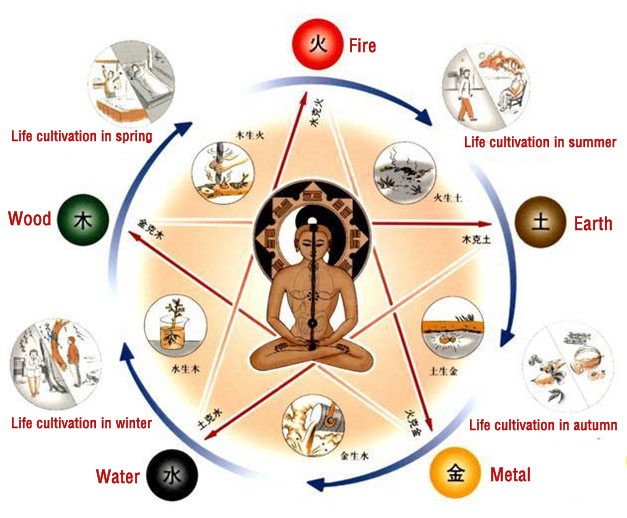Since wood, fire, earth, metal and water are five categories of the main objects in the natural world, possess specific properties and depend on each other to exist, people in ancient China divided and explained the properties of things according to the characteristics of the five elements.
As to the characteristics of the five elements, the early understanding concentrated on the primary properties of wood, fire, earth, metal and water in the natural world, such as "water moistens and flows downward", "fire flames up", "wood can be flexed and extended", "metal can be changed in form" and "earth can grow crops", etc. In order to explain the properties of more things, people abstracted the properties of the five elements for extensive application and extended their implications.
For example, the properties of flexing and extending, growth and development as well as free activity all pertain to the category of wood; warmth, heat, ascending and brightness all pertain to the category of fire; reception, cultivation and transformation all pertain to the category of earth; change, depuration and astringency all pertain to the category of metal; and moistening, downward movement, cold and coolness as well as closure and storage all pertain to the category of water.

In the light of the basic properties of the five elements, analogy and induction can be used to categorize things in order to decide the properties of different things. The first step is to compare the image, properties and functions of things with the abstracted properties of the five elements respectively. If it is similar to the properties of one element, then it pertains to the category of that element.
For example, the sun rises in the east according to the geographical location of China. In this case the east is similar to wood in properties, so it pertains to wood. The south is hot and similar to fire in properties. So the south pertains to fire. The west is mountainous with high terrain and cold climate, similar to the properties of metal. That is why the west pertains to metal. The north is cold and snowy with deeply latent terrestrial qi, similar to the properties of water. Thus the north pertains to water. The central region of China is mild in climate and rich in crops, similar to the properties of earth. Therefore the central region pertains to earth.
Take the four seasons for another example. Spring, characterized by gradual ascendance of yang-qi, warm weather and resuscitation of all things, is similar to the properties of wood. So spring pertains to wood. Summer, characterized by hot weather and luxuriant growth of all things, is similar to the properties of fire. That is why summer pertains to fire. Autumn, characterized by decrease of yang-qi and decline of all things in the natural world, is similar to the properties of metal. Thus autumn pertains to metal. Winter, characterized by cold weather and storage of all things, is similar to the properties of water. For this reason winter pertains to water.
For dealing with things difficult to compare directly with the abstract properties of the five elements, inference and deduction can be used to decide the properties of these things in the light of the properties of other related things induced according to the defined properties of the known things. Take the liver for example. The physiological characteristic of the liver is to function freely, quite similar to the properties of wood. So the liver pertains to wood in the five elements. However, the gallbladder, tendon and eyes are difficult to compare with the properties of the five elements directly. Because these organs and tissues are intrinsically related to the liver, they also pertain to wood.
In this way TCM classifies, with the methods of categorization, inference and deduction, various things in the natural world as well as the viscera, organs and tissues in the human body respectively into the categories of wood, fire, earth, metal and water according to their properties, thus formulating a structural system of the five elements with close interrelationship between the internal and external environments of the body.
This structural system of the five elements mainly includes the five flavors, the five colors, the five transformations, the five kinds of qi, the five directions and the five seasons as well as the five zang-organs, the five fu-organs, the five sensory organs, five constituents (tendon, vessel muscle, skin and bone), the five emotions, the five kinds of liquids and the five states of pulse in the human body as illustrated in the following table.







